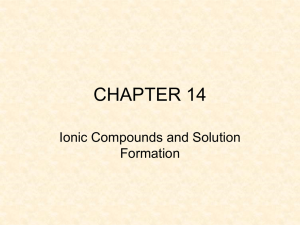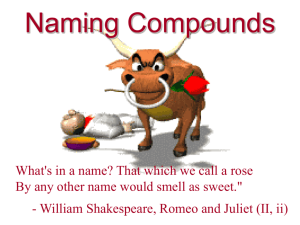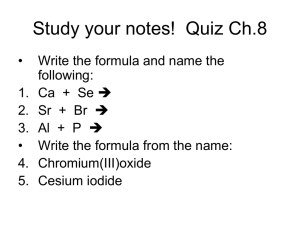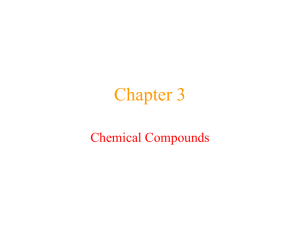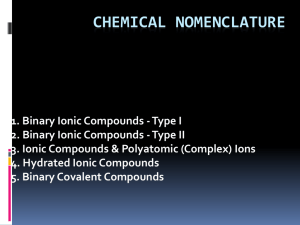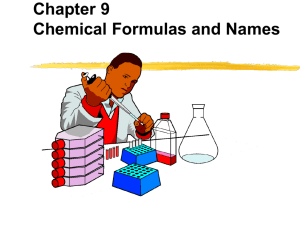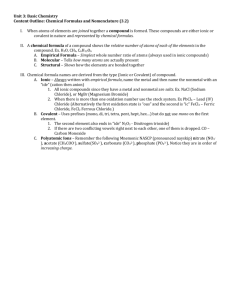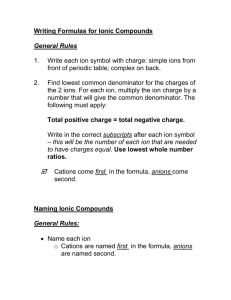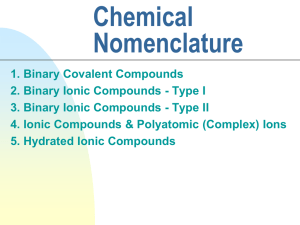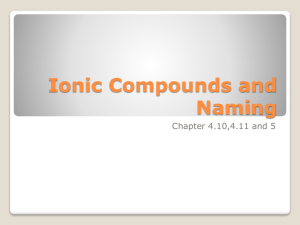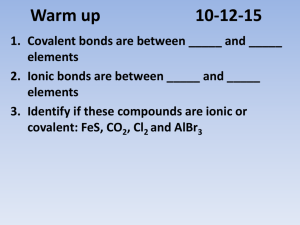Chapter 7 – Chemical Formulas and Chemical Compounds
advertisement
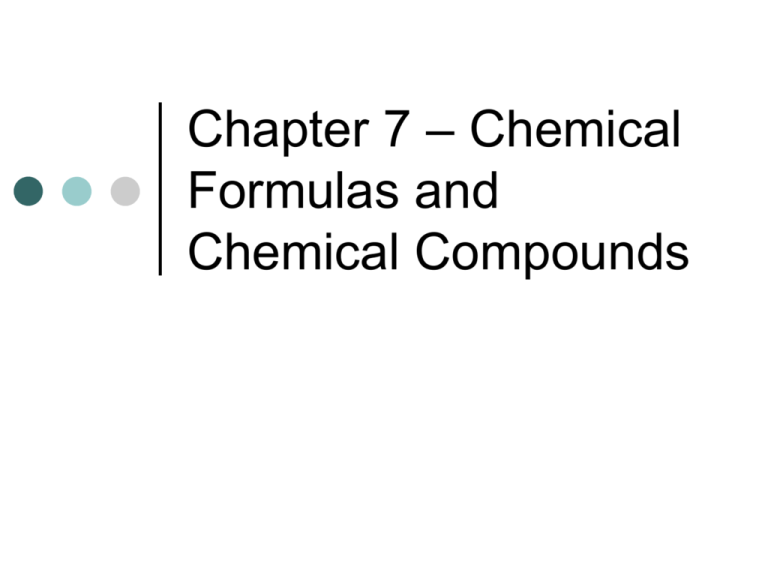
Chapter 7 – Chemical Formulas and Chemical Compounds 7-1 Chemical Names and Formulas What’s so important about a chemical formula? It indicates the relative # of atoms of each kind in a chemical compound Molecular Compound: chemical formula reveals the # of atoms in a single molecule. C8H18 Ionic Compound: consists of a lattice of positive and negative ions held together by mutual attraction. Simplest ratio NaCl Al2(SO4)3- How many atoms are there? Al 2 S 3 O 12 Monoatomic Ions Ions formed from a single atom Ex. Na Na1+ , O O2 Not all main-group elements form ions, C and Si form covalent bonds instead of ionic bonds Sn and Pb are exceptions lose only 2 e-s instead of 4 or sometimes they keep all 4 electrons. Naming Monoatomic Ions Cations are identified by the elements name Anions the ending of the element’s name is dropped. The ending –ide is added. Ex. Fluorine (F) = Fluoride ion (F-) Nitrogen (N) = Nitride (N3-) Flash Cards may be useful to memorize these!!!! Binary Ionic Compounds Compounds composed of two different elements. Ex. Magnesium and Bromine form Magnesium Bromide, MgBr2 Rules for Ionic Compounds 1. Write the symbols for the ions side by side. The cations go first. 2. Cross over the charges by using the absolute value of each ion’s charge as the subscript for the other ion. Al 3+ O 2- Al2O3 3. Check subscript and divide them by their largest common factor to give the smallest possible whole-number ration. 4. Write the formula Write the formula for the following: Magnesium and iodine Potassium and sulfur Aluminum and chlorine Zinc and bromine Cesium and sulfur Strontium and oxygen Calcium and nitrogen MgI2 K2S AlCl3 ZnBr2 Cs2S SrO Ca3N2 Name the following: BaF2 CaO AgF CdO K3N NaI AlBr3 Barium Fluoride Calcium Oxide Silver Fluoride Cadmium Oxide Potassium Nitride Sodium Iodide Aluminum Bromide The Stock System of Nomenclature Some elements form two or more ions such as Fe, with different charges. This system uses Roman numerals to indicate an ions’ charge Fe 2+ or Fe 3+ FeCl2 = iron (II) chloride FeCl3 = iron (III) chloride Write the formula and give the name for the following: Cu + and O 2Fe 3+ and S 2Cu 2+ and Cl Sn 2+ and Cl Hg 2+ and O 2Sn4+ and S 2V 2+ and F V 4+ and Br - Name the following: CoI2 HgI2 PbS2 CuBr2 Compounds Containing Polyatomic ions Oxyanions- polyatomic ions containing oxygen Nitrate vs. Nitrite – (-ite less oxygen) NO3- and NO2- Sulfates, Nitrate, Chlorates Write the formulas for: Copper(II) nitrate Potassium iodide Sodium hydroxide Ammonium acetate Calcium carbonate Potassium permanganate Sodium sulfate Iron(III) nitrate Name the following: Ag2S NaMnO4 Ba(OH)2 NH4NO3 Fe(ClO)2 Ca(NO3)2 K2SO3 NaCH3COO Naming Binary Molecular Compounds # 1 2 3 4 5 6 7 8 9 10 # Mono Di Tri Tetra Penta Hexa Hepta Octa Nona deca Rules for Molecular Compounds 1. The least electronegative element is first. It is given a prefix if it is more than one 2. the second element is named by combining a prefix, the root of the word, and –ide ending 3. the o or a at the end of the prfix is usually dropped when the word following begins with another vowel. Examples. As2O5 = diarsenic pentoxide PF5 = phosphorus pentafluoride XeF4 = Xenon tetrafluoride CCl4 = carbon tetrachloride Carbon dioxide = CO2 Dinitrogen pentoxide = N2O5 Sulfur hexafluoride = SF6 Dinitrogen monoxide = N2O Acids and Salts Acids can be binary acids or oxyacids Binary acids are acids that consist of H and a halogen, HCl hydrochloric acid Oxyacids, contain H, P and a third element, Sulfuric Acid, H2S Pg 214
